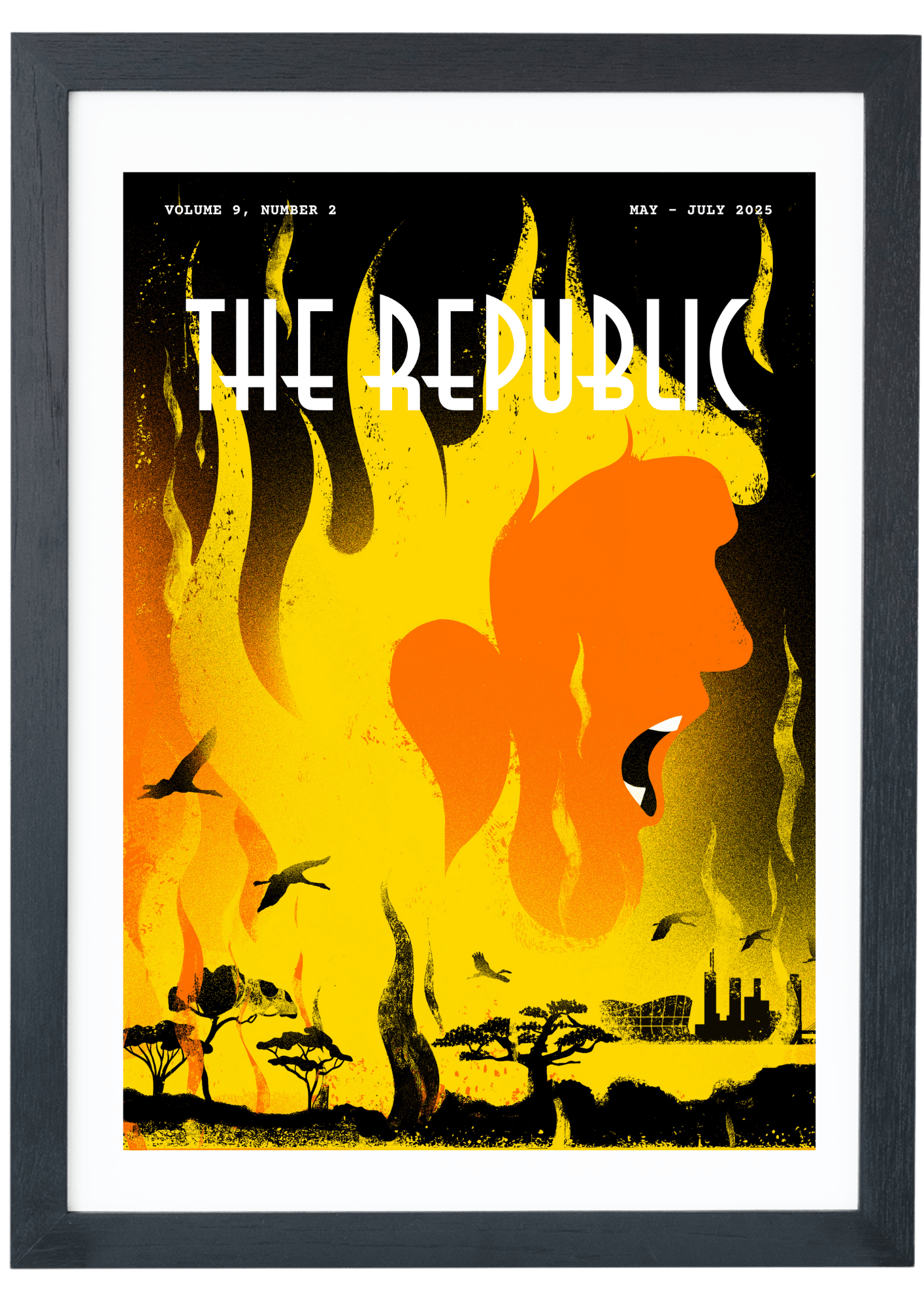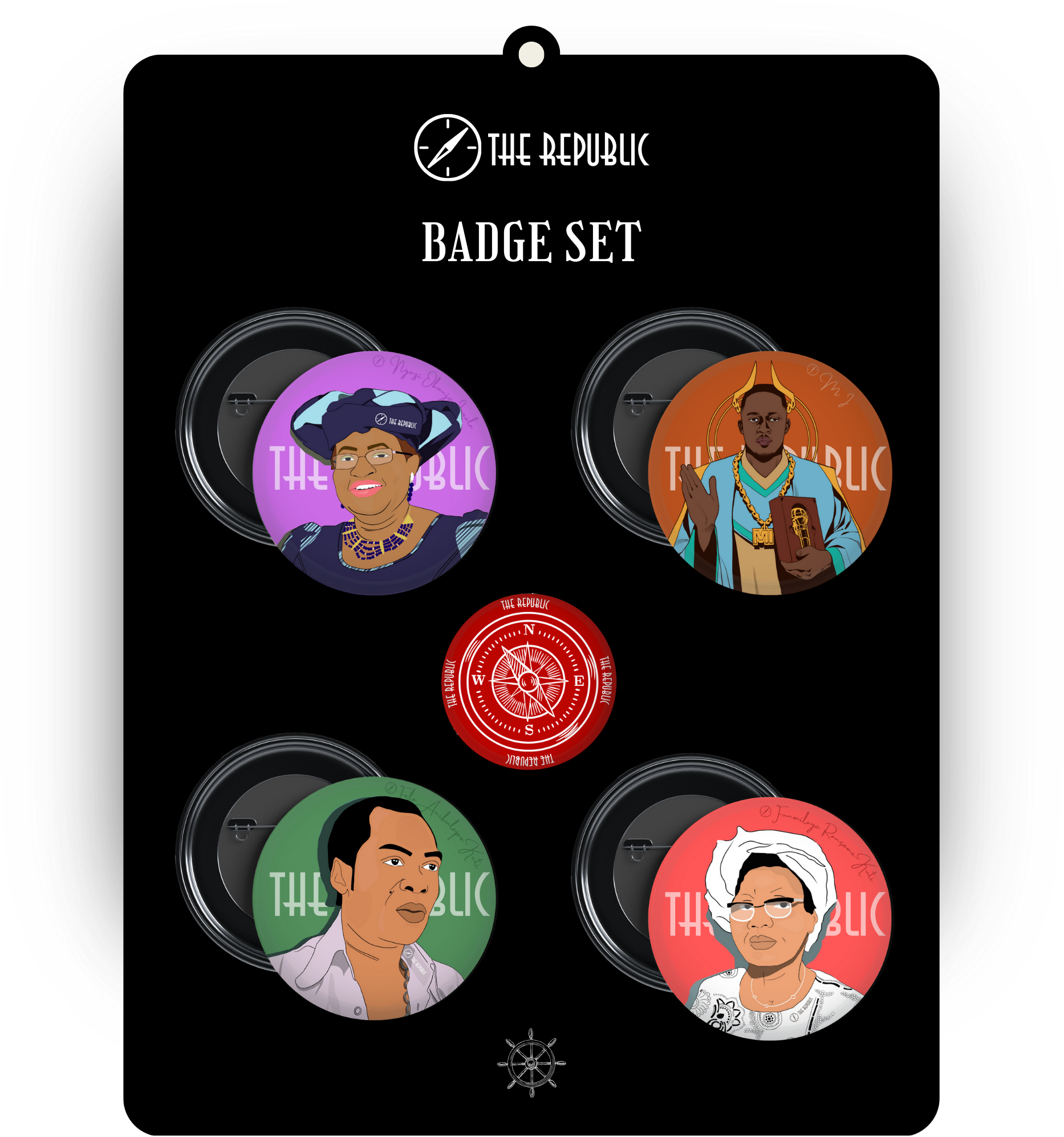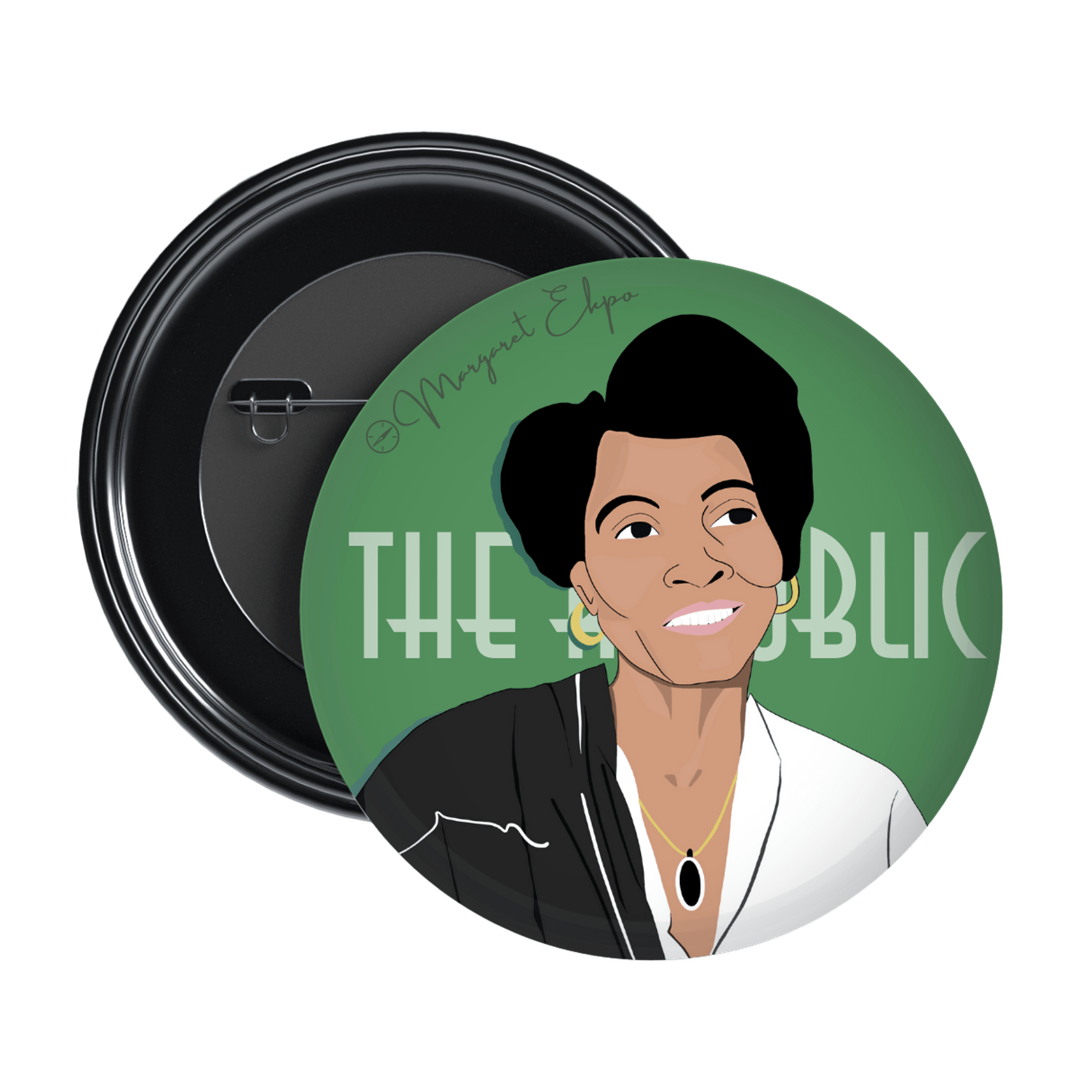
Photo illustration by Ezinne Osueke / THE REPUBLIC. Source Ref: Eleshin Oba Movie / THIS DAY LIVE
THE MINISTRY OF CULTURAL AFFAIRS
Historical Fabulations and the ‘Potentially Queer’ in New Nollywood Epics

Photo illustration by Ezinne Osueke / THE REPUBLIC. Source Ref: Eleshin Oba Movie / THIS DAY LIVE
THE MINISTRY OF CULTURAL AFFAIRS
Historical Fabulations and the ‘Potentially Queer’ in New Nollywood Epics
In the opening scene of the film Ẹlẹṣin Ọba, Odunlade Adekola, playing the titular king’s horseman, is seen stretched out on an elegant bamboo bed, adorned with raffia leaves and beautifully patterned adire. He is flanked on all sides by beautiful women, most of whom are only clad around their waists. They all reach for the king’s horseman, who reclines, basking in the excess of sensuous attention around him. Many who saw the film or who at least know Wole Soyinka’s original play, Death and the King’s Horseman, from which the film was adapted, would know that the scene was setting the stage for a story about the horseman’s lascivious greed and, in the climax of the story, his ultimate failure to perform his sacred duties. A second look at the scene, however, suggests a possibility of queer reading—a vision of group intimacy, bodies clustered together on the single bamboo bed, women leaning sensuously towards the horseman and in the process, against one another.
The image of this scene was courted by a litany of criticism from viewers who had the opinion that nudity is a very recent touch in Nigerian cinema, probably only serving a mimetic role in relation to American cinema. Others welcomed it as realistic and celebrated the boldness of actors who can animate such scenes. While the image generated no public reading of queerness (in the way it is generally used in contemporary lay discourse), it seemed to unsettle a significant number of viewers to show how images of sex and modes of embodiment are central to how we define culture.
Ẹlẹṣin Ọba is one example in a growing list of epic dramas that New Nollywood (characterized by its turn to ‘more open-ended and less didactic’ narrative tropes) has taken up in the last few years. From Anikulapo to House of Ga’a, the epic continues to make its mark as an important cinematic genre, captivating younger audiences and engendering new curiosities about cultural histories. Scintillating as these epics have been to collective memory, they continue to elicit questions about how much can be remembered against the backdrop of protracted interjections of histories and ancillary erasures.
Nostalgia-driven as they are, these films are wrought in highly poetic Yoruba, showcasing colourful traditional clothing and steeped in the educative lores of African spiritualities. Speaking in an interview about his 2022 film, Anikulapo, award-winning filmmaker, Kunle Afolayan, tells us that, ‘The Yoruba story is even yet to be scratched… Trust me, if you dig deep into the Yoruba culture, the Igbo culture, the Hausa Culture, the Ibibio, Benin… you will not…want to do anything in English because all these cultures have deep stories.’ While one might be somewhat weary of the implicit danger of essentialism in his comment about a coherently contained structure that is ‘the Yoruba culture’, many would sympathize with the moral imperative of this project of recovery—the need to excavate, especially for a younger generation of Nigerians who are so disconnected from these realities, a repertoire of stories that will tell us about our pasts.
A SPECTRUM OF POSSIBILITIES
These stories, one begins to find out, are not monolithic but varied. As the light of discovery is refracted through the medium of the storyteller’s eye, the promise of a rainbow is birthed. I draw, pointedly, on the symbolism of the rainbow for two reasons that are connected, if tied to seemingly disparate genealogies. The first is that, as a biblical allusion, the rainbow was a promise against alluvial erasure. In the second sense, the rainbow in contemporary consciousness has come to represent queer freedom, resilience against the specific erasure of difference by the heteronormative world order. Through the act of remembering in new epic films—where the artist-excavator reanimates forgotten histories, and the viewer engages with the material presented by filmmakers through keen attention and interpretation—a sense of the potentially queer unfolds. While mainstream understandings of the word ‘queer’ often limit it to sexual practice, I adopt the more expansive definition proposed by African sexuality scholars, Rachel Spronk and S. N. Nyeck, who describe it as ‘a horizon of curiosity and imprecision.’ In this sense, queerness encompasses a range of embodied practices that unsettle normative ideas of what is deemed proper.
By suggesting that new Nollywood epic films have queer potential, I highlight how they introduce moments, characters, and scenes that disrupt normative tropes of being and embodiment. Take Afolayan’s Anikulapo, for instance. We are in Oyo Kingdom, in the seventeenth century, a town bustling with festivity and enterprise and we encounter a wealthy unattached (or plurally attached) woman, Awarun, who oversees dozens of workers in her pottery business and is well-known for her string of younger male lovers. A meddlesome neighbour tells her latest love interest, Saro, about how she uses men to fulfil her sexual needs, empowers them, and discards them. He warns: ‘Àwàrún f’ojú j’obìnrin àmó̩ o̩kùnrin ni’ (Awarun has the form of a woman, but she is a man). Scholars like Oyèrónkẹ́ Oyěwùmí and Ifi Amadiume have explored instances of such gendered disruptions in precolonial Yoruba and Igbo societies respectively, in which women like Awarun participated in gender role reversals. The character of Awarun, therefore, recalls a moment in history where gendered dichotomies could be safely less rigid and women who were enterprising and plurally loving, could thrive even when they unsettled societal norms about women’s roles.
shop the republic
THE COLONIAL FLOOD
Kenyan scholar, Keguro Macharia, has explored the connection between colonial modernity and queerness. Macharia shows how the disavowal of women like Awarun was central to how colonial governments sought to manage the distributive practices of labour, wealth and intimacy that did not align with the state’s extractive projects. Enterprising women in urban contexts were particularly targeted for control. The colonial state often figured them as prostitutes because their freedoms to wander, trade and choose the modalities of their intimate lives unsettled the order of the state. According to Macharia, ‘the figure of the prostitute in colonial Africa, came to represent a destabilizing queerness, not rooted specifically in same-sex desires and practices, but rooted, more precisely, in a reorganization of intimate life and socioeconomic arrangements.’ To unsettle the space-times of colonial modernity, for Macharia, was to be ‘potentially queer’.
Colonial governments sought to contain a vast and plural range of intimate practices that were opened up by the space of the potentially queer. Today, these erasures continue to abound in the moral anxieties about sexuality in so-called postcolonial Africa, where practices that unsettle normative models of intimacy are disavowed as ‘unAfrican’ and, therefore, criminalized. In recent history, same-sex intimacies are the most brutally targeted practices.
Even though the new epic films have not definitively represented same-sex intimacy (except to offer suggestive hints and affordances like the Ẹlẹṣin Ọba example that opened this essay), viewers have criticized the depictions of intimate scenes, citing the preservation of an imagined African morality. Yet, this moral order is ironically more tied to the history of colonial erasures than to a primordial past. Responding to these critics, Afolayan tells BBC Yoruba that the people commenting negatively on the portrayal of nudity need only go back to the theatre of Hubert Ogunde, lead dramatist and pioneer director of the Yoruba Travelling Theatre, to see that these portrayals are not new or foreign. The first important point here is that Afolayan dismisses the idea of foreignness by tracing the genealogy of his work to that of a prominent figure in Yoruba cultural production rather than to Western origins. Second and more crucially, in defending the authenticity of his representations, Afolayan does not make claims to any pristine source of Yoruba culture but draws on another moment in the history of the creative representation of said culture. For Afolayan, then, creative representation is the source of culture. He concretizes this point when, in a final word to his critics, he says: ‘I am the director, in any case. I will tell my stories however I please and anyone who doesn’t like it, can create their own.’
shop the republic
AFTER THE FLOOD: A PROMISE OF RE-CREATION
Divested of its polemics, Afolayan’s invitation to create is particularly salient against the backdrop of colonial erasures. In the face of these erasures, the project of cultural excavation is always necessarily in tandem with a project of creation. In acknowledging how Black histories have been erased by violent encounters, American historian Saidiya Hartman proposes a method of ‘critical fabulation’ as a corrective to the omissions of history connected to these encounters. Critical fabulation is that ‘speculative voice’ in film, art, literature, ‘that imagine(s) what cannot be verified.’ Speaking specifically to the erasure of intimate pluralities in past and present African life, Macharia reminds us too that ‘queers need fabulation…to imagine and theorize and practice strategies that make our being possible.’ Part of this creativity, I would join many Africanist scholars to argue, is to find the queer affordances in practices of being and intimacy beyond what is legible within the fluencies of LGBT studies as defined by the West, and to trace, through figures like Awarun, ‘the dissonant intimacies’ that unfold across African life worlds.
shop the republic
-
‘Make the World Burn Again’ by Edel Rodriguez by Edel Rodriguez
₦70,000.00 – ₦75,000.00Price range: ₦70,000.00 through ₦75,000.00 This product has multiple variants. The options may be chosen on the product page -
‘Nigerian Theatre’ Print by Shalom Ojo
₦150,000.00 -
‘Natural Synthesis’ Print by Diana Ejaita
₦70,000.00 – ₦75,000.00Price range: ₦70,000.00 through ₦75,000.00 This product has multiple variants. The options may be chosen on the product page -
‘Homecoming’ Print by Shalom Ojo
₦70,000.00 – ₦75,000.00Price range: ₦70,000.00 through ₦75,000.00 This product has multiple variants. The options may be chosen on the product page
shop the republic
In closing, let me return to the image of the rainbow. The biblical flood that precedes its appearance is heavy with symbolism. Through the histories of slavery, colonial conquests and their afterlives, Black people have known floods—rivers—of erasure. These interjected histories have left only scant memories of the possibilities of being and intimate life on the African continent prior to these violent erasures. But the rainbow came after the flood—as existential and narrative possibility. What the rainbow represents is, in fact, the opening of the world to the varied possibilities of existence, life in plural without the threat of blanket erasure. The new Nollywood epic film, in an effort to fill the yawning gaps of African cultural histories, offers narrative openings that are filled with queer potential. Yet, as Afolayan notes, these efforts have only begun to scratch the surface of what is possible in epic storytelling as a means of cultural excavation. Thus, the rainbow too is an invitation to fabulate—and to do so without the strictures of a parochial understanding of what difference (or, more precisely, queerness) should mean⎈
BUY THE MAGAZINE AND/OR THE COVER
-
‘Natural Synthesis’ Print by Diana Ejaita
₦70,000.00 – ₦75,000.00Price range: ₦70,000.00 through ₦75,000.00 This product has multiple variants. The options may be chosen on the product page -
The Republic V9, N1 Demas Nwoko's Natural Synthesis And The Rise of African Architecture
₦30,000.00
















